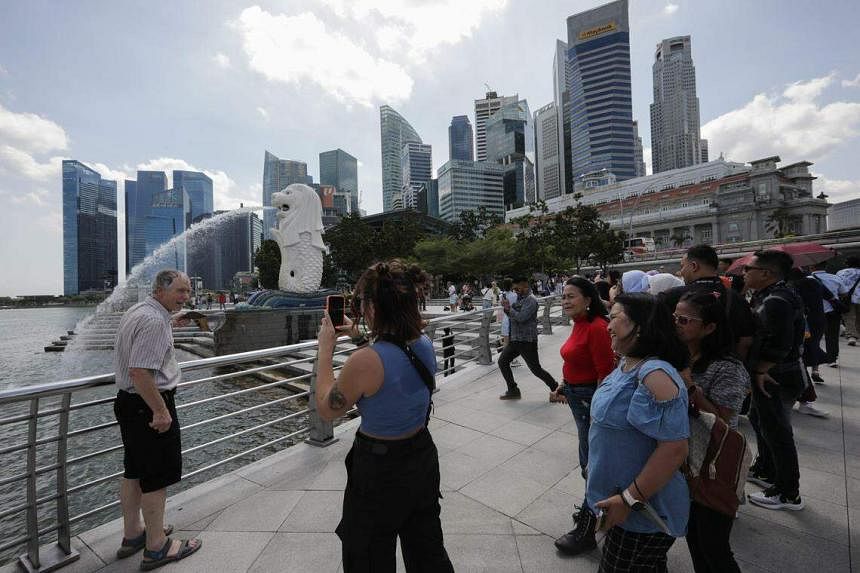The Singapore Tourism Board (STB) stated last week that visitor numbers to the city-state surpassed expectations, with more than 2.9 million arrivals in the first three months of this year.
This statistic represents 62% of the 4.7 million individuals that visited Singapore in the first quarter of 2019.
A total of 193,230 of them arrived from India, which is almost 3.5 times the 54,530 who arrived in 2022.
In the first quarter, Indian citizens were the fourth largest source of tourists, after only Indonesians (523,300), Malaysians (278,910), and Australians (265,730).
With 168,960 visits, Americans were the fifth largest group of visitors by country of origin.
China, which was Singapore’s top source of tourism in 2019 with over 3.75 million visits, has yet to completely return and made up the ninth largest group of tourists in Q1 with only 124,560 visitors.
According to data from China’s National Bureau of Statistics, approximately 170 million Chinese tourists travelled abroad in 2019.
Although China has loosened travel restrictions, arduous travel processes targeted at Chinese citizens early this year by nations such as South Korea and Japan dampened excitement for outbound travel.
This has been worsened by delays in passport renewals and visa applications, as well as Chinese airlines’ inability to operate as many flights as before COVID.
According to data from a travel booking service, foreign flights out of China were less than 10% of what they were in 2019.
Additionally, three years of COVID-19 limitations have transformed the travel patterns of Chinese citizens, with many now satisfied to experience the enormous and varied attractions in their own country.
The Chinese tourists we will welcome this year and in the coming years are very different from those who came before, Wolfgang Georg Arlt, founder and chief executive of COTRI (Chinese Outbound Tourism Research Institute), was quoted by a news agency as saying at ITB Berlin, the world’s largest tourism trade fair.
COTRI is an independent consulting company based in Germany.
In China as elsewhere, years of pandemic-induced lockdowns sparked a shift away from major tourist attractions toward more nature-orientated, more outdoor-orientated tourism, Arlt said.
He highlighted the emergence of trends like camping and glamping, as well as family-focused trips, a news agency cites.
According to COTRI, Chinese outbound travel will rebound to roughly two-thirds of 2019 levels this year, with over 110 million abroad visits.
Nevertheless, the Singapore Tourism Board is not waiting for the return of Chinese tourists to develop new activities and attractions to enhance tourism on the island.
STB and the Infocomm Media Development Authority (IMDA) announced the creation of an SGD 10 million (USD 7.5 million) Singapore On-screen Fund to encourage tourists to visit Singapore through TV shows and films.
The fund’s goal is to assist international media and entertainment (M&E) partners in marketing Singapore to a worldwide audience through television and cinema programmes.
The Singapore On-screen Fund will assist chosen projects by prominent M&E firms that are situated in Singapore and will be released before the first quarter of 2027.
Winning projects will get up to 30% financing support for qualifying expenditures associated with highlighting Singapore, including production and marketing costs.
This is partly inspired by previous partnerships that resulted in films like “Crazy Rich Asians,” the blockbuster K-drama “Little Women (2022),” and the HBO sci-fi smash series “Westworld Season 3.” (2020).These shows had a global influence and made a pleasant impression on spectators all across the world.
The resumption of the Free Singapore Tour, which is popular with Indian visitors as well as those from Australia and Indonesia, was also announced in April.
The tour was put on hold during COVID.
This tour is organised by STB in collaboration with Changi Airport and is intended for transit passengers having a stopover of at least five and a half hours but less than 24 hours at Changi.
To participate in the trips, they must also hold valid entrance visas to Singapore.
The goal of organising these free excursions is to attract transit travellers to make Singapore their next vacation destination.
The City Sights Tour, Heritage Tour, and Jewel Tour, which were available prior to COVID, have been updated to incorporate new areas of interest.
A brand-new Changi Precinct tour will present visitors to the fascinating sights and sounds of Singapore Changi Airport’s eastern sector.
Each trip will take two and a half hours and will be accessible every day, with hopes to gradually rise to nine tours each day.
Almost 80,000 people took the Free Singapore Tour in 2019.
Another interesting prospect is the five-year stationing of a brand-new Disney Cruise Line ship in Singapore beginning in 2025.
On March 29, STB and Disney Cruise Line established a memorandum of understanding.
The 208,000 gross-ton ship, which can carry 6,000 guests and a crew of 2,300, will take tourists on cruises across Southeast Asian countries, which are home to more than 40 UNESCO World Heritage Sites.
Throughout the five-year timeframe, the Disney Cruise Line ship has the potential to add millions of local and foreign cruise passengers, including fly-cruise customers who arrive in Singapore by air. It is also predicted to have a big positive impact on the overall economy.
“We look forward to welcoming the magic of Disney Cruise Line to Singapore in 2025,” ANI quoted Keith Tan, Chief Executive of STB, as saying.
This is an important milestone for STB and reflects Disney Cruise Line’s strong confidence in Singapore and Southeast Asia.
The new Disney cruise ship will be an attraction itself and is expected to boost the tourism sector in Singapore for many years to come.
Tags: Chinese Outbound Tourism Research Institute, COVID-19 pandemic, Disney Cruise Line, Singapore Tourism Board (STB), Keith Tan, Tourism, travel restrictions, UNESCO World Heritage sites

